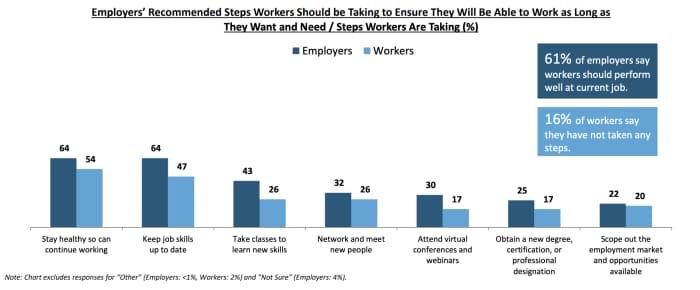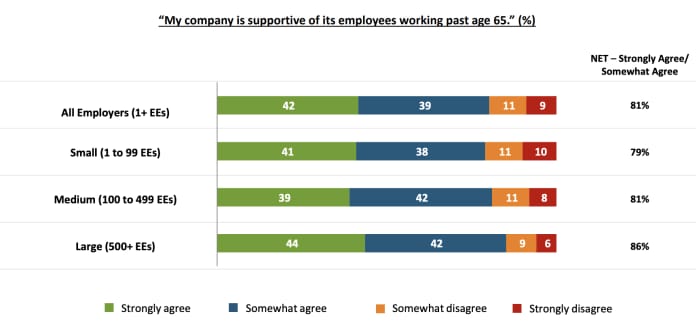Planning to work longer? How to stay in the job you love.
Staying healthy, keeping job skills up to date, and taking classes to learn new skills are the best ways to stay relevant no matter where you are in your career, employers said in a recent study. The problem is that workers don’t necessarily do these things.
In a recent study by the Transamerica Institute, employers’ top picks to help employees work as long as they want include some basic tips every employee should keep in mind.
“Our work lives and careers are journeys. There are things we need to do every step of the way, from entering the workforce to building our careers in those final years. And many opportunities are being missed,” said Catherine Collinson, executive director and president of the nonprofit Transamerica Institute and Transamerica Center for Retirement Studies. “Start now. You don’t want to wait until your 40th or 50th or 60th birthday to start doing these things.”
Read: “I needed something to do”: How work in retirement is being embraced by older adults and businesses
The top recommendations from employers were to stay healthy and keep their job skills up to date (both 64%), while 61% of employers say workers should perform well in their current job. Taking new courses, networking, attending virtual conferences or webinars, or earning a new degree, certification, or job title were also among the top tasks employers considered important.

Transamerica Institute
When asked what steps they take, workers are most likely to say that they stay healthy so they can keep working and keep their job skills up to date (54% and 47%, respectively). But only 26% of those workers took classes to learn new skills, and 26% networked and met new people. The study found that overall 16% of workers did not take any steps. The study included a survey of 1,874 employers and 5,493 employees.
“People have competing priorities over time. People spend a lot of time at their jobs and sometimes find that they have to invest their own time to invest in their careers,” Collinson said.
Read: After 50 years of progress, how well prepared are women for retirement?
It is becoming increasingly important to keep skills up to date throughout a career as people expect to live and work longer.
The study found that today’s workers plan to live to be 85, with 12% planning to live to be 100 or older. The survey compared the projected life expectancy of workers to the expected retirement age and found that 25 years was the average number of years workers are expected to spend in retirement.
“As people plan to live to be 100 or more, we are redefining what it means to retire. It’s more of a transition, not a finite department where you work full-time one day and not at all the next,” Collinson said.
If someone plans to retire at 65 and lives to 105, they would spend almost as much time working as they do in retirement.
“How do you save enough to fund a 40-year retirement in a 43-year career? The numbers don’t add up,” Collinson said. “The world is changing fast. Someone who decides to retire at 65 and live to 105, what will the world be like then? Forty years is a long time.”
“There’s an old saying that the hardest thing to get your first job is because you don’t have work experience and connections,” Collinson said. “Imagine retiring early and realizing you have to go back to work and re-entering the workforce at 70?”
More than eight in ten employers (81%) agree that they support their employees over 65, including 42% who totally agree and 39% who tend to agree.
Another discrepancy the study found was that employers viewed themselves as age-friendly, while employees did not.
“Employers may lack a certain confidence,” Collinson said.

Transamerica Institute
While most employers (84%) rated their companies as “age-friendly” by offering opportunities, work arrangements, and the training and tools necessary for employees of all ages to be successful, only 65% of workers felt their employers were so . According to the study, this gap was consistent across all company sizes.
Only 34% of employers had a formal diversity and inclusion (D&I) policy statement that explicitly includes age among other commonly mentioned demographics.
Of those employers who do not list age as part of their D&I policy statement, 29% plan to employ one in the future and 30% do not plan to. Large and medium-sized companies are more likely to have adopted an age-related D&I policy than small companies.
In the past, older workers have been overlooked in employers’ hiring practices, but the study suggests that change may be on the way.
Among those hiring during the pandemic, nearly six in 10 employers gave “a lot” or “quite a lot” consideration to applicants over the age of 50 compared to younger applicants.
“Older workers and experienced workers aged 50+ represent a huge untapped potential. They have historically been an overlooked opportunity for hiring and retention,” said Collinson.
Large and medium-sized companies were more likely to do this than small companies. More small companies reported that their company had no job applicants aged over 50 compared to medium and large companies.
“The power of an intergenerational workforce is that it brings together diverse ideas, passions and skills and is a dynamic way to share ideas and opportunities to collaborate,” said Collinson.